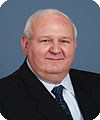1.Does the current economy affect inventory levels?
2.What about the inventory levels of R-22 versus R-410A? Any trends to observe?
3.How has the aftermath of 13 SEER affected the supply chain? Have things returned to “normal” as far as inventory levels of 13 SEER equipment and higher?
One distributor, Doug Young of Behler-Young Co., said that “normal” is not like it used to be. “I would like to say everything is normal but recently normal has changed,” he said. “The new normal for inventory levels is much lower than what it was two years ago.”
David Williams of the Gateway Supply Co. said that the past year has been a “feeling out” of the market as new products and trends have dominated. “Last year brought many questions and challenges,” he said. “The 13 SEER mandate was a challenge without question, but the manufacturer we buy from also introduced 97 new product families. They introduced along with the new 13 SEER platform an entire array of R-410A offerings, including high SEER offerings, many of which we had never had available to us before.
“Therefore, without knowing which way the market would sway, we had to stock up on everything. Now that we have had a year with the new product offerings and now that we have a clear understanding of our customers demands, we have been able to adjust our inventory levels accordingly.”

David Williams
THE ECONOMY AND INVENTORY LEVELS
“As a distributor, we adjust our inventories according to movement,” said Joe Rettig of The Habegger Corp. “With the RNC [residential new construction] market being slower, our inventory of RNC products decreases. When the manufacturer has excess inventory, they shut down their product lines until inventories are in balance with orders. This can cause a problem when a given size product is needed and the manufacturer is shut down for inventory readjustments.“The AOR [add-on/replacement] market appears to be somewhat strong, so a high level of inventories is needed to support this market. The replacement market supports the higher-efficiency products, so inventory dollars are definitely up in this market. In our market, this high-end product market is a Puron market.”
Michigan is going through some very tough economic times right now, and Young, whose business is Michigan-based, said that his business has definitely been affected. “Residential new construction is down all over the country and it is really down in Michigan,” he said. “There is also an economic softness which has impacted equipment replacements - it seems more homeowners and even building owners are choosing to fix rather than replace.”
South Carolina doesn’t face the same economic pressures as Michigan, but Williams said he has to keep an eye on inventories and adjust them according to trends. “I believe that the Southeastern states have been very fortunate with regards to the fluctuation in the economy,” he said. “I have heard that many markets across the country have realized significant slowdowns in new construction. We, too, have realized some slowdowns, but overall the economy has held.
“Of course we are constantly adjusting the inventory levels to adapt to the current conditions. We are also seeing the changeout market slow a bit with many home- owners opting to repair instead of replace. I would presume that with the additional cost of the higher-SEER equipment that homeowners have to be more frugal with their disposable income.”
The RNC business has impacted the sale of compressors, according to Michael Senter of ABCO Refrigeration Supply Corp. “With respect to compressor sales, we certainly have seen an increase in residential replacement compressor sales as compared with replacing the condensing unit alone since system match-up issues are of concern, meaning that manufacturers are concerned about matching a new, replacement 13 SEER condensing unit with an existing air handler designed for 10 SEER or lower SEER systems,” he said. “That said, the jump in replacement compressors for residential units is not nearly as large as some experts had predicted.
“Instead, quality contractors are convincing educated consumers to improve energy efficiency by investing in new, higher SEER systems by replacing both the internal units as well as the condensing units. This approach also has led to an increase in the sale of higher-SEER R-410A units as well.”
North of the border in Canada, the economic fortunes of HVACR distributors are linked to the actions of the government, according to Tom Boutette of Ontario’s Boutette & Barnett Trade Distribution Centre. “In our market the provincial government has set up rebate programs to homeowners for installing 14 SEER or higher equipment,” he said. “Because of this rebate, the distributors in this province must stock 13, 14, 16 or even higher SEER equipment. Our inventory is even further inflated by the need for R-22 and R-410A equipment.”

Joe Rettig
R-22 VERSUS R-410A
Boutette went on to say that R-22 refrigerant is still popular as long as it is useable. “There seems to be a trend toward more R-410A equipment sales, but there is still a core of customers who want the cheapest R-22, 13 SEER equipment they can find,” he said. “I suspect there will be a demand for R-22 equipment for as long as it is available.”Rettig said that as a Bryant/Carrier distributor, R-410A or Puron sales have been a strong part of his company’s sales efforts since 1998. He added that other than the RNC market, he does not sell many R-22 units. “Since units carry five- and 10-year warranties and R-22 units will become obsolete in 2010, most of our dealers do not want to sell units that will become obsolete in three short years,” he said. “We address the more price-sensitive replacement market with a different line of equipment, and this is still an R-22 market, but even demand for R-410A is shifting upward in this more price-sensitive market.
“It appears that smaller dealers or one-man shops still prefer to sell R-22 products. This may be because they do not have the necessary R-410A training and the necessary test equipment. Other than builders, we found very few people interested in 10 SEER units when the 13 SEER units were mandated. We see R-22 units following the same pattern.”
Young said his product mix of R-22 and R-410A is approaching the 50-50 levels. Williams said his company is getting close, too. “R-410A is becoming more and more the refrigerant of choice,” he said. “We are not yet at 50-50, mainly because of the quantity of new construction we provide, which, for the most part, has stayed with R-22. However, on the change-out side, I would say we are close to the 50 percent mark.
“I do believe that with R-22 increasing in price almost weekly, a dealer is doing their customer a disservice when they sell them an R-22 unit right now. I do not think we are that far away from seeing R-22 and R-410A near the same price.”
Senter said as long as commercial business is strong, there will be a demand for R-22. “On the commercial side of our business in major cities like New York, Philadelphia, and Boston, we are seeing an increase in R-22 compressor replacements as compared with condensing unit change-outs when systems experience difficulties,” he said.
“New commercial systems, however, overwhelmingly are R-22 units. It will be fascinating to experience and participate in the change from R-22 to R-410A in the commercial sector at the close of 2009 and in 2010.”

Doug Young
AFTERMATH OF 13 SEER
Young said that the market shift to 13 SEER provided no “major surprises” for his company. “We were in pretty good shape with 10 SEER products in early 2006,” he said. There still are some old-style items, but we are moving them out. Like with all product changes, customers typically want the new models. There are always old units that don’t move, and distribution ends up taking a hit.”Rettig noted that the 13 SEER products have had a physical impact on his business. “The 13 SEER mandate has affected how many units that we can store in our warehouses,” he said. “We have had to rent additional warehouse space to maintain our inventory levels to serve our customers. When renting off-site warehousing or renting semi-trailers for warehousing on our lot, this decreases the efficiencies concerning how quickly a wholesaler can serve his customers.
“We now get fewer units on a delivery truck, so it is a challenge to maintain the same delivery efficiencies as before because of the fewer units on a truck requires more deliveries or more trucks and drivers. Offloading delivery trucks is now more challenging. In many cases, one man cannot offload the larger units, so you either send two people on a delivery truck or you must make sure that able body people are awaiting the delivery person at the delivery site to help with offloading of the units. Back injuries are more of a challenge for warehouse people and delivery people with the heavier 13 SEER units.
“If 13 SEER units cost a wholesaler 30 percent more than 10 SEER units, then the wholesaler’s inventory cost went up by a minimum of 30 percent to stock the same number of units. To stock the same number of units means more warehouse space, so this is another increased cost to the wholesaler. The manufacturers, as suppliers, have returned to normal production or supply lead times have returned to normal. Generally speaking, there are limited problems in getting equipment from the manufacturer.”
Thirteen SEER seems to have caught on in the Northeast, where Senter said his customers are “excelling at selling entire new 13 SEER-plus systems even though it is a more expensive and time-consuming solution for consumers. That’s important since we are told that consumers are concerned about increasing energy efficiency in the face of escalating energy costs.
“This is a particularly interesting trend in the Northeast where summers are relatively short in duration. It is even more interesting that many of these consumers are willing to invest in higher SEER systems that reach 15-16 seasonal energy efficiency ratings.”
Publication Date:07/23/2007

Report Abusive Comment